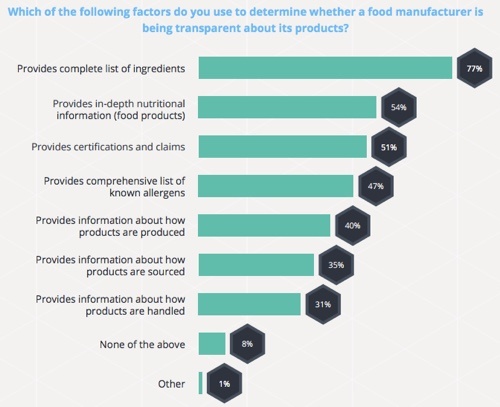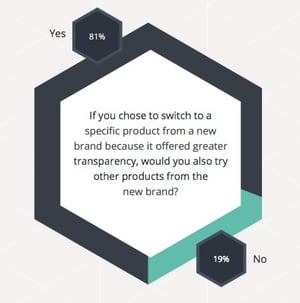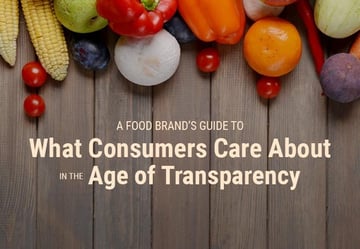For today's consumer, giving them just the product information required by law on a label is no longer enough.
In the report "Driving Long-Term Trust and Loyalty Through Transparency," Label Insight surveyed more than 2,000 consumers around transparency and whether it affects their trust or loyalty toward a food brand.
In this post, we'll look at why providing transparency to a consumer is the clear choice, especially when a consumer will look elsewhere if you don't provide it. Without transparency, you're ceding control of your brand promise to a 3rd party.
what kinds of transparency matter to consumers?
When consumers are making their choice for a food purchase or restaurant visit, they want to know not only what's in their cart or on their plate, but where it came from. They want to know as much as possible about what they’re eating: how the food is produced, clear and accurate labeling, and information on ingredients and sourcing. From Label Insight's report, here are the main transparency factors consumers care about:
 Image Courtesy Label Insight
Image Courtesy Label Insight
Given the factors that consumers care about listed above, how can your brand go about building trust? The key is providing clear, relevant information. Nebulous terms like "reduced fat" and "healthy living" can mean different things to different people. Personal preferences vary widely, and having full product information at hand is the easiest solution to providing the best customer experience.
is transparency worth it for companies?
 If you look at recent trends, the writing is on the wall. The definition of food safety is changing, and quickly. With the arrival of FSMA, you can no longer afford to be reactive in your food safety preparedness, and the same can be said for your food transparency practices.
If you look at recent trends, the writing is on the wall. The definition of food safety is changing, and quickly. With the arrival of FSMA, you can no longer afford to be reactive in your food safety preparedness, and the same can be said for your food transparency practices.
In the past, we've profiled 5 brands that are winning at transparency and the rewards they've been reaping. If consumers cannot find the information they want through your product's packaging or webpage, they'll turn to the internet at large - and there is no way to control what happens at that point. Gone are the days where consumers take brand claims at face value - they must be backed up by facts and clear product information.
Image Courtesy Label Insight
how can companies deliver food transparency?
Transparency begins with deep insights about your own supply chain. Can you trace from farm-to-fork, rather than one-up-one-down? In order to deliver the rich information consumers are demanding, you'll need a supply chain traceability software that makes gathering your supplier information fast and accurate.
Transparency that breeds customer loyalty starts with deep knowledge of your supply chain. Take a step toward supply chain visibility with our free guide, Selling the C-Suite on Supply Chain Traceability Software.
Other posts you might be interested in
View All Posts
Food Safety
5 min read
| September 1, 2016
The Case for Food Ingredient Transparency
Read More
Food Industry
8 min read
| May 25, 2022
Six Key Factors Driving Consumer-Mandated Supply Chain Transparency
Read More
Food Industry
4 min read
| November 7, 2019


